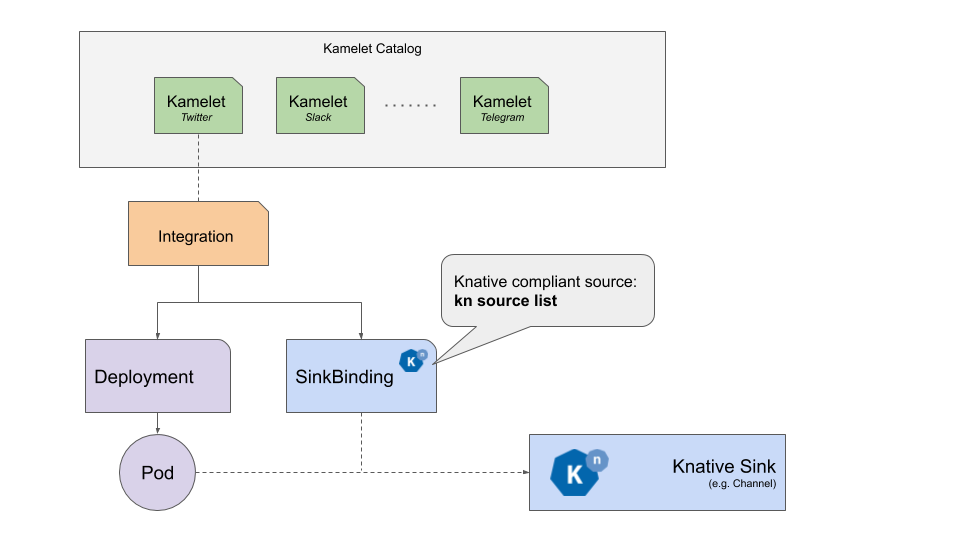Sources
| This document describes features that will be available in Camel K 1.2.x (not released at the time of writing: August 08, 2020) |
One of the goals of Camel K is to provide connectors that can be easily installed on any Kubernetes cluster and used when needed to provide data to internal services or publish data outside, without requiring any in-depth knowledge about Apache Camel from the end-users.
Knative Sources fall into this category, but in general, sources described here can be used with any underlying technology.
| Knative CamelSources are a community effort to provide specific sources for Knative. What we describe in this document is a more general approach that is alternative to Knative CamelSources and aims to supersede them. |
Sources Design
The following diagram shows how sources are materialized from their elementary building blocks.

Kamelets as Abtract Sources
In the context of sources, Kamelets play the role of abstract sources that can be materialized once the user provides values for all mandatory parameters contained in the Kamelet specification.
What follows is a simple Kamelet that can produce periodic events with a specified payload:
apiVersion: camel.apache.org/v1alpha1
kind: Kamelet
metadata:
name: timer
spec:
definition:
title: "Timer"
description: "Produces periodic events with a custom payload"
required:
- message
properties:
payload: (1)
title: Payload
description: The message to generate as payload of each Cloudevent
type: string
# continues with the flow declaration
# ...| 1 | The definition of the payload property |
The Kamelet contains the definition of all properties in JSON Schema format. In this example, there’s only a single property named payload.
A Kamelet does nothing when created on a cluster, but it can be used later to create sources, as explained in the remainder of this document.
Integration: binding a Kamelet to a destination
An integration can be used to bind a Kamelet to a destination, providing values for all the Kamelet parameters.
For example, the following integration binds the timer Kamelet to the Knative InMemoryChannel named mychannel:
apiVersion: camel.apache.org/v1
kind: Integration
metadata:
name: timer-source
spec:
flows:
- from:
uri: kamelet:timer (1)
parameters:
payload: "Hello World" (2)
steps:
- to: knative:channel/mychannel?apiVersion=messaging.knative.dev/v1beta1&kind=InMemoryChannel (3)| 1 | Reference to the Kamelet named timer |
| 2 | Value for the payload required property (and others, if present) |
| 3 | Destination of the generated events |
When binding a Kamelet to a single (fully specified) Knative destination, Camel K does not attempt to do any binding, instead it delegates the actual mapping to a Knative SinkBinding resource.
The SinkBinding intercepts the creation of the Deployment containing the integration specification, to inject the
exact coordinates of the destination (in the example, of the InMemoryChannel named mychannel).
This mechanism works also if the integration is materialized into a Knative Serving Service or into a CronJob, not only if a
standard Deployment is used.
The SinkBinding resource is also interpreted at Knative level as a standard source, so the kn CLI is able to properly recognize
it. UI tools based on Knative, e.g. the OpenShift console, should also be able to display it as a standard source.